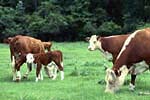| Sustainable Food Guide | Environmental Practice at Work © 2005  |
Issues | BSE Information... TV pictures of cattle staggering and collapsing spread public horror for this appalling condition in the UK national herd. The epidemic lasted six years with over 180,000 cases confirmed in the UK between November 1986 and November 2002. Most of the herds (63%) affected are dairy herds, 27% are beef suckler herds. This reflects the fact that dairy cattle receive more supplementary feed, which used to contain meat and bone meal, than do beef suckler cattle. Since 1989, BSE has been confirmed in much of western and eastern Europe, and in Canada, Israel, Japan and Oman. The greatest concentration, outside of UK, is in France, Germany, Ireland, Spain and Switzerland. Some of these contaminations are due to same habit of feeding MBM, others have imported the disorder. For distribution of BSE by countries. BSE has now been found Canada and USA. Many countries are boycotting their beef.
The Food Standards Agency, in 2003, lifted the ban on human consumption of older cattle (known as the Over Thirty Month or OTM rule), as the UK is now only a "medium" risk. New legislation to replace the OTM rule by BSE testing was introduced September 2005 More | ||||||||


